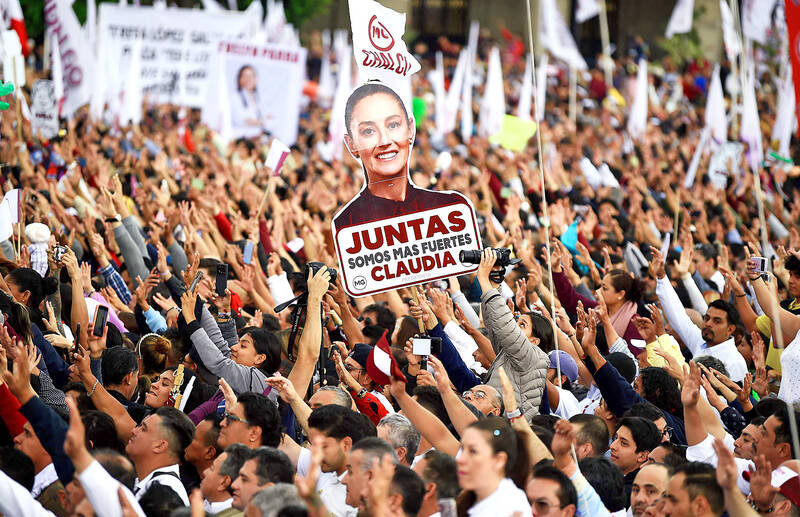Claudia Sheinbaum on Tuesday was sworn in as Mexican president, riding the enthusiasm over her predecessor’s social programs, but also facing challenges that include stubbornly high levels of violence.
After a smiling Sheinbaum took the oath of office on the floor of Congress, legislators shouted: “Presidenta. Presidenta,” using the feminine form of president in Spanish for the first time in more than 200 years of Mexico’s history as an independent country.
The 62-year-old scientist-turned-politician receives a country with a number of immediate problems, including a sluggish economy, unfinished building programs, rising debt and the hurricane-battered resort city of Acapulco.

Photo: AFP
In her inauguration speech, Sheinbaum said that she came to power accompanied by all of the women who have struggled in anonymity to make their way in Mexico, including “those who dreamed of the possibility that one day no matter if we were born as women or men we would achieve our dreams and desires without our sex determining our destiny.”
She made a long list of promises to limit prices for gasoline and food, expand cash handout programs for women and children and support business investment, housing and passenger rail construction.
However, any mention of the drug cartels that control much of the country was brief and near the end of the list.

Photo: AFP
Sheinbaum offered little change from former Mexican president Andres Manuel Lopez Obrador’s “hugs not bullets” strategy of addressing root causes and not confronting the cartels, apart from pledging more intelligence work and investigation.
“There will be no return to the irresponsible drug war,” she said.
She has pledged to continue all of Lopez Obrador’s policies, even those that bolstered the power of the military, and weakened the country’s checks and balances.
After the inauguration, Sheinbaum attended a rally in Mexico City’s colonial-era main plaza to participate in a ceremony involving an all-women committee representing Mexico’s approximately 70 indigenous groups.
Sheinbaum was blessed and brushed with herbs and incense by Ernestina Ortiz, a “spiritual guide,” who told Sheinbaum: “You are a voice for all of us who had no voice for a long time.”
An indigenous elder then handed Sheinbaum a wooden “staff of authority,” like those carried by community leaders.
After the ceremony, Sheinbaum said she would push for a total ban on any public servant being re-elected to office.
Lucia Ruiz, a 42-year-old mother of three, was one of thousands trying to reach the main square to see the rally.
She said she hoped Sheinbaum would combat high rates of violence against women in the country.
“She is going to represent us,” Ruiz said. “We have always been governed by men, and they think we’re incapable, but we’re not. We are the head of our families.”

Former Nicaraguan president Violeta Chamorro, who brought peace to Nicaragua after years of war and was the first woman elected president in the Americas, died on Saturday at the age of 95, her family said. Chamorro, who ruled the poor Central American country from 1990 to 1997, “died in peace, surrounded by the affection and love of her children,” said a statement issued by her four children. As president, Chamorro ended a civil war that had raged for much of the 1980s as US-backed rebels known as the “Contras” fought the leftist Sandinista government. That conflict made Nicaragua one of

COMPETITION: The US and Russia make up about 90 percent of the world stockpile and are adding new versions, while China’s nuclear force is steadily rising, SIPRI said Most of the world’s nuclear-armed states continued to modernize their arsenals last year, setting the stage for a new nuclear arms race, the Stockholm International Peace Research Institute (SIPRI) said yesterday. Nuclear powers including the US and Russia — which account for about 90 percent of the world’s stockpile — had spent time last year “upgrading existing weapons and adding newer versions,” researchers said. Since the end of the Cold War, old warheads have generally been dismantled quicker than new ones have been deployed, resulting in a decrease in the overall number of warheads. However, SIPRI said that the trend was likely

BOMBARDMENT: Moscow sent more than 440 drones and 32 missiles, Volodymyr Zelenskiy said, in ‘one of the most terrifying strikes’ on the capital in recent months A nighttime Russian missile and drone bombardment of Ukraine killed at least 15 people and injured 116 while they slept in their homes, local officials said yesterday, with the main barrage centering on the capital, Kyiv. Kyiv City Military Administration head Tymur Tkachenko said 14 people were killed and 99 were injured as explosions echoed across the city for hours during the night. The bombardment demolished a nine-story residential building, destroying dozens of apartments. Emergency workers were at the scene to rescue people from under the rubble. Russia flung more than 440 drones and 32 missiles at Ukraine, Ukrainian President Volodymyr Zelenskiy

Indonesia’s Mount Lewotobi Laki-Laki yesterday erupted again with giant ash and smoke plumes after forcing evacuations of villages and flight cancelations, including to and from the resort island of Bali. Several eruptions sent ash up to 5km into the sky on Tuesday evening to yesterday afternoon. An eruption on Tuesday afternoon sent thick, gray clouds 10km into the sky that expanded into a mushroom-shaped ash cloud visible as much as 150km kilometers away. The eruption alert was raised on Tuesday to the highest level and the danger zone where people are recommended to leave was expanded to 8km from the crater. Officers also